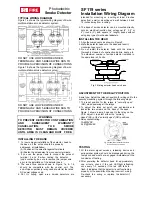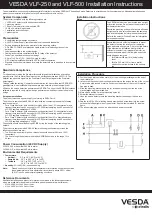
4
WHERE YOU SHOULD NOT INSTALL SMOKE ALARMS
• Do not install a smoke alarm within close proximity of heating and
cooling supply vents or within close proximity of return or fresh air
vents. Smoke may be blown away from the smoke alarm by the
supply vents, or could be diffused or reduced by being diverted into
the return air vent. The NFPA states in Standard 72E, Section 4-4.1:
“In rooms, buildings, where forced ventilation is present, detectors
shall not be located where air from supply diffusers (“vents”) could
dilute smoke before it reaches the detector.”
• Do not install your smoke alarm in an area where the temperature
may fall below 40°F, or rise above 100°F. Smoke alarms are designed
to work safely only within these temperature ranges, and failure to
alarm, improper alarms or nuisance alarms may result from operation
outside these temperature limits.
• Do not install a smoke alarm in damp or very humid areas (such as
bathrooms with showers) where the normal humidity may rise above
93% relative humidity. Above this level, moisture may condense
inside the smoke chamber and cause false alarms.
• Do not install a smoke alarm in an area where particles of combustion
are normally present, such as kitchens or automobile garages, unless
the smoke alarm has a False Alarm Control feature.
• Do not install a smoke alarm in dusty or dirty areas; SUCH AN INSTAL-
LATION CANNOT BE RELIED UPON. An accumulation of dust and dirt
in the sensing chamber may block the openings and prevent an
alarm, or may get inside the alarm and cause false alarms. If a smoke
alarm is required in such an area, vacuum it frequently and test it
according to the section
TAKING CARE OF YOUR SMOKE ALARM
.
• Do not install a smoke alarm in the dead air space in the corner
where the wall meets the ceiling. If in doubt as to the exact location
of mounting, for your safety, contact your local fire department for
help in choosing a location.
• Do not install a smoke alarm where bugs or insects are present
before eliminating or minimizing the bug problem. Although all smoke
alarms built since 1986 are made to help prevent bugs from entering
the detection chamber, bugs may build up on chamber openings and
prevent smoke from entering. As a result, unit should be vacuumed
frequently as explained in the section
TAKING CARE OF YOUR
SMOKE ALARM
.
• Do not install a smoke alarm within close proximity of a fluorescent
light. Electrical noise may cause nuisance alarms.
HOW TO INSTALL YOUR SMOKE ALARM
AFTER HAVING CAREFULLY READ THE PREVIOUS SECTIONS OF THIS MANUAL,
YOU ARE READY TO INSTALL YOUR SMOKE ALARM.
PLEASE FOLLOW THESE DIRECTIONS:
1. Place mounting bracket on ceiling or wall
in prearranged location and use a pencil
to trace two opposing hole positions for
mounting screws. Drill two holes using a
1/16 in. (1.5mm) drill bit. See Figure 6.
2. Use mounting screws provided for
attaching to studs or woodwork. For
plaster or plasterboard, you may wish to
use plastic anchors and screws. In this
case, drill two holes using a 3/16 in. (5mm)
drill bit in the centers of the hole locations
and insert anchors into holes. See Figure 6.
3. Screw mounting bracket to surface securely.
TO INTERCONNECT ALARMS:
Do Not Use a Junction Box to Facilitate Interconnection of Alarm
FOR INTERCONNECT LINE ONLY
use #14-#18 AWG minimum solid or
stranded wire. When interconnecting, maximum wire length
between any two is 1,500 feet for #18 AWG or 4,000 feet for #14 AWG
(20 OHMS loop resistance).
To provide greater protection the model TPCI smoke alarms can be
interconnected so that multiple units will alert you to a dangerous
situation.
This smoke alarm may be interconnected with as many as 11 Firex
Model TPCI smoke alarms (12 units maximum). Do not connect any
other type or model of smoke alarm. Push the supplied terminal block
onto the pins in the base of the smoke alarm. See Figure 6A.
FIGURE 6
FIGURE 6A
110-1009D Engl 1/11/07 10:59 AM Page 4


























